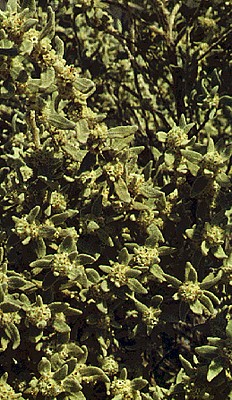 Voucher: Haegi 1100 . Photo: L. Haegi © L. Haegi |
 Line drawing by M. Perkins (from L.Haegi, unpubl. thesis). |

Synonymy
Cyphanthera odgersii subsp. occidentalis Haegi, Telopea 2: 178 (1981)
T: Cowcowing railway siding, W.A., 23 Sept. 1976, L. Haegi 1100; holo: PERTH; iso: AD, CANB, K, MO.
[Anthocercis odgersii F. Muell. sensu A.J. Ewart, Victorian Naturalist 23: 155 (1907).]
Description
Shrub to 2.5 m, greyish. Branches densely woolly-tomentose with mainly branched, non-glandular hairs, with some glandular hairs; hairs 1–6.5 mm long.
Leaves broadly to narrowly ovate-elliptic, almost sessile, 18–35 mm long 7–13 mm wide, woolly-tomentose.
Flowers in dense clusters, often forming leafy spikes; pedicels 0.5–2 mm long. Calyx 4–7 mm long, pubescent in lower half, woolly above. Corolla 5.5–8.5 mm long, sparsely pubescent outside, densely pubescent inside, white, the striations purple; lobes ovate to broadly ovate, 1.3–1.8 mm long. Stamens 1.3–3 mm long; filaments pubescent at base with non-glandular hairs only.
Capsule ellipsoid to ovoid, 3–5 mm long. Seeds 2.8–3.4 mm long.
Distribution and ecology
Known from only a few localities in the central wheat-belt of south-western W.A.
Occurs on sand plains.
Common name
Western Woolly Cyphanthera
Notes
Distinct from subsp. odgersii by its longer leaves, shorter corolla lobes and usually longer (1-6.5 mm long vs to 2 mm long) hairs on the branches.
The Interim Recovery Plan (1999-2002) for Western Woolly Cyphanthera, available at www.environment.gov.au/biodiversity/threatened/publications/recovery/c-odgersii/index.html
contains further background to this species in its habitat.
Phylogeny
Phylogenetic studies by Garcia & Olmstead (2003) on the Tribe Anthocercideae using two chloroplast DNA regions included this species The studies indicated that Cyphanthera is not monophyletic. Cyphanthers odgersii showed a closer relationship to Grammosolen while the rest of the Cyphanthera species combined to form a clade with Duboisia and Crenidium.
Reference: V.F.Garcia & R.G.Olmstead (2003). Phylogenetics of Tribe Anthocercideaea (Solanaceae) based on ndhF and trnL/F sequence data. Systematic Botany 28: 609-615.
Selected specimens
W.A.: Cowcowing, M. Koch 1104 (AD, MEL, NSW, PERTH).
Derivation of epithet
Named for William Odgers, a correpondent of Mueller. Ssp. occidentalis has a more westerly distribution than ssp. odgersii and is named for this fact, occidentalis being Latin for western.
Images and information on web
Images of C. odgersii ssp. occidentalis can be seen on the Western Australia Herbarium Florabase website at http://florabase.calm.wa.gov.au/browse/photo?f=315&level=s&id=11751 and on the Canberra Botanic Gardens site at http://www.anbg.gov.au/images/photo_cd/J01112585F5/038.html
Pharmacology: A discussion of the tropane alkaloids which occur in Cyphanthera and other Anthocercideae can be found in Griffith & Lin (2000).
Ref: W.J. Griffin & G.D. Lin (2000). Chemotaxonomy and geographical distribution of tropane alkaloids. Phytochemistry 53: 627–628.
Plant status (if any)
Declared as R = Rare Flora - extant based on Atkins (2008). See http://florabase.calm.wa.gov.au/conservationtaxa
Atkins, K.J. (2008). Declared Rare and Priority Flora List for
Listed as Endangered under the Commonwealth EPBC Act - see www.environment.gov.au/cgi-bin/sprat/public/publicspecies.pl?taxon_id=14002 where an interim recovery plan is also available.